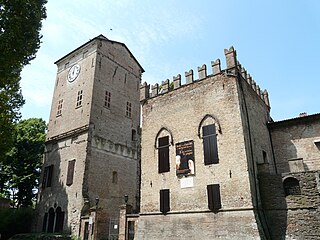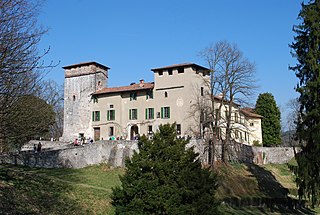
The Duchy of Parma and Piacenza was an Italian state created in 1545 and located in northern Italy, in the current region of Emilia-Romagna.

The House of Farnese was an influential family in Renaissance Italy. The titles of Duke of Parma and Piacenza and Duke of Castro were held by various members of the family.

The Rocca Sanvitale, or Sanvitale Castle, is a fortress residence in the centre of the town of Fontanellato, near Parma, northern Italy. Construction of the moated block, accessible through a drawbridge, was begun in the 13th century, mostly completed by the 15th century, with embellishments continuing through to the 18th century. It is prototypical of the urban castle-houses of the turbulent medieval communes of Northern Italy. Until the 1930s it was the home of the descendants of the Count of Sanvitale.

Bardi is a comune (municipality) in the Province of Parma in the Italian region Emilia-Romagna, located about 130 kilometres (81 mi) west of Bologna and about 50 kilometres (31 mi) southwest of Parma, in the upper Ceno valley at the confluence of the rivers Ceno and Noveglia. It is dominated by the imposing Landi Castle built over a spur of red jasper.

Castello di Compiano is a castle at the top of Compiano's hill, in the province of Parma, northern Italy.

Rocca dei Rossi is a castle located at piazza Mazzini #12 in the town of San Secondo Parmense, province of Parma, in the Italian region Emilia-Romagna. A different Rocca dei Rossi, also known as Castello di Roccabianca, is located in the town of Roccabianca.

Montechino Castle is located in Montechino village, in the municipality of Gropparello, in the Riglio valley, province of Piacenza, Italy. It is situated on the crest of Monte Occhino hill, overlooking the Riglio river.

Castello di Reschio forms part of a chain of walled settlements in proximity of the Tuscan boundaries. It belonged to the county of Porta Sant’Angelo of the commune of Perugia, perched on a hillock above the valley of Pierle, along the right riverbank of the Niccone stream. Today it is part of the communal territory of Lisciano Niccone, province of Perugia.

The Visconti Castle of Bereguardo, Castello Visconteo of Bereguardo in Italian, is a medieval castle in Via Castello 2, Bereguardo, Province of Pavia, Lombardy, Italy.

The Visconti Castle, or Castello Visconteo, is a castle in the town of Cusago near Milan, Lombardy, Northern Italy. It was built in the 14th century by Bernabò Visconti and used as a hunting lodge by him and other Visconti family members. The castle underwent significant changes in the Renaissance period; today, it is in neglected conditions.

The Visconti Castle of Massino is a medieval castle located on the Vergante hills in the municipality of Massino Visconti, Province of Novara, Piedmont, northern Italy. Since the 12th century it has been a possession and one of the preferred residences of the Visconti of Milan. At that time it was frequented by the family ancestor of the lords and dukes of Milan. Afterwards its property was transferred to other collateral branches of the lineage, from the initial Visconti di Massino to the current Visconti di San Vito.

The Visconti Castle of Crenna is a castle of mediaeval origin located in Crenna, frazione of Gallarate, Lombardy, Northern Italy. It is linked to the fame of Lodrisio Visconti, who raised against and then reconciled with the members of the family of his cousin Matteo Visconti, Lord of Milan. In the 14th century, the castle underwent expansion and destruction according to the alternative fortunes of Lodrisio.

The Visconti-Castelbarco Castle is a castle of mediaeval origin located in Cislago, Lombardy, Northern Italy. Since the 13th century it belonged to a cadet branch of the Visconti House. In the 18th century it became a property of the Castelbarco family.

The Visconti Castle of Castelletto is a castle of mediaeval origin located in Castelletto sopra Ticino, Piedmont, northern Italy. It is named after the Visconti house, to which it belonged between the 13th and the 20th century.

The Visconti Castle of Fagnano is a castle located in Fagnano Olona, Lombardy, northern Italy. It lies at the border between the town of Fagnano and the Olona valley.

Pietà with Saints Clare, Francis and Mary Magdalene is a 1585 oil on canvas painting by Annibale Carracci, now in the Galleria nazionale di Parma.

The Visconti Castle of Jerago is a castle of Middle Age origin located in Jerago, Lombardy, Northern Italy. Having been a property of members of the Visconti house between the 13th and 18th centuries, it retains still today their memory in its name.

The Visconti Rocca of Castell'Arquato is a Rocca in the medieval town of Castell'Arquato, Emilia Romagna, Northern Italy. It was erected on the site of a previous fortification by Luchino Visconti in the 14th century after his family acquired Castell'Arquato.

The Agazzano Castle is a fortification located in Agazzano, in the province of Piacenza. The castle is located on the edge of Agazzano town, not far from the main square, which was intended to be defended by the castle, and it is located in the heart of the Luretta Valley, a short distance from the course of the Luretta creek, at a point of slight elevation difference, where the last hill extensions of the Ligurian Apennines give way to the Po Valley.



















